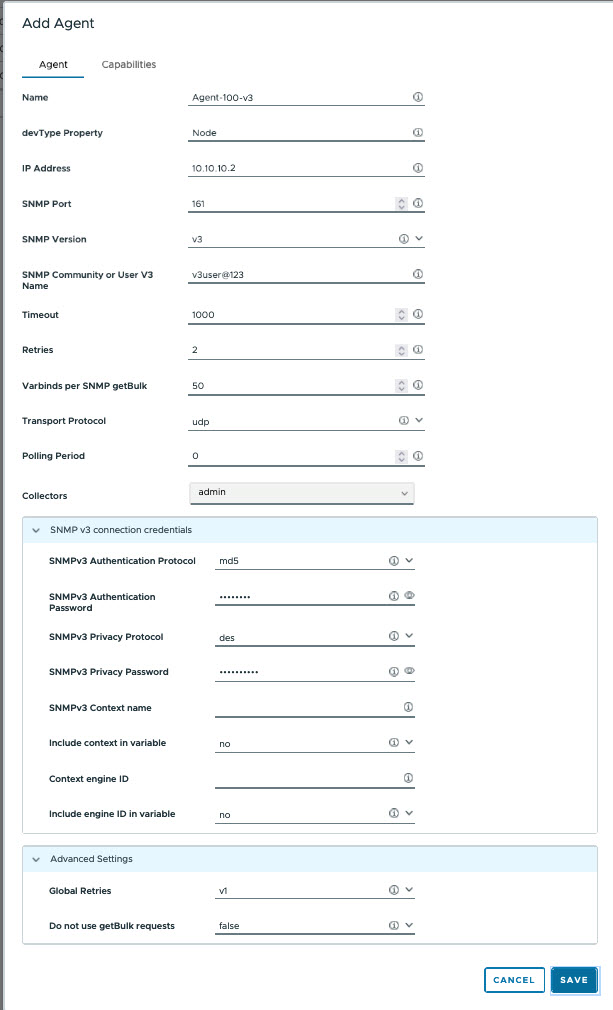You can add Agents manually or import seed files to upload agents in bulk.
Procedure
- To add Agents manually, follow the procedure:
- Click Add, and enter the parameters as displayed in the following table:
Input Parameter Description Default Value Name Name of the agent. NA devType Property Specifies the type of device this agent represents. NA IP Address Specifies the IP address of the polled agent which will be used to contact the device. 0.0.0.0 SNMP Port Specifies the port used in order to contact the SNMP agent on the polled device. 161 SNMP Version Specifies the SNMP version to use when polling the agent. V2C SNMP Community or User v3 Name Specifies the community string or SNMP v3 username, depending on the selected SNMP version. Public Timeout Specifies the timeout, in milliseconds, before giving up while waiting for the agent response. 1000 Retries Specifies the number of retries before giving up while contacting the agent. 2 Varbinds per Snmp getBulk Specifies the maximum number of varbind in a snmpGetBulk request issued to the device. 50 Transport Protocol Specifies protocol to use for data transportation UDP Polling Period Specifies the polling period, to be used by the polling group containing this agent. 300 Collectors Specifies the names of the collectors to which this agent can be distributed. NA Capabilities Specifies the capabilities assigned or excluded from the agent along with their polling periods. By default, the polling period assigned to each capability is 0. Miscellaneous SNMP agent polling options Global Retry Specifies the opportunity to issue another call when all retries have failed, using either snmpGet (v1) or snmpGetBulk (v2c) requests. V1 Do not use getBulk requests Specifies only get and getNext requests on agent. False Table 1. SnmpV3 specific attributes SNMP V3 credentials Description Default Value SNMPv3 Authentication Protocol Specifies the protocol used for authentication process. NoAuth SNMPv3 Authentication Password Specifies the authentication password. NA SNMPv3 Privacy Protocol Specifies the protocol used for privacy. NoPriv SNMPv3 Privacy Password Specifies the privacy password. NA SNMP v3 Context name Specifies the authentication password. NA Variables include context Specifies the context name as part of the raw values variable for the agent. False Context engine ID Specifies the engine ID, as a hexadecimal format character string. NA Variables include engine ID Specifies the context engine ID as part of the raw values variable for the agent. False 
- To import agents through seed file, click Import > Browse and select the separator from the Select Separator drop down.
You can upload a seed file in two formats, a comma separated file, or a tab separated file:
- Comma - You can provide csv files of three different syntaxes:
- Basic agent - ipAddress, name
- Standard agent - ipAddress, name, snmpCommunityOrUserV3Name, snmpPort, snmpVersion, [collectorName, pollingPeriod, capability, doNotDiscoverCapability]
- Full agent - name, ipAddress, snmpPort, transportProtocol, timeout, retries, snmpVersion, snmpCommunityOrUserV3Name, snmpV3AuthenticationProtocol, snmpV3AuthenticationPassword, snmpV3PrivacyProtocol, snmpV3PrivacyPassword, devtype, onFailTryWith, [collectorName, pollingPeriod, capability, doNotDiscoverCapability]
- Tab - You can provide a tab separated .txt file with key value pairs of the attributes. For example:
name=name1 snmpPort=161 devtype=Router ipAddress=192.168.0.1 capability=ipsla snmpCommunityOrUserV3Name=commString1
The attributes enclosed in [] are non-mandatory attributes and can be skipped.
Note:- For tab separated .txt files, the supported keys are:
Attribute Names name devtype doNotUseGetBulkRequests ipAddress onFailTryWith transportProtocol snmpPort timeout retries snmpVersion snmpCommunityOrUserV3Name snmpV3AuthenticationPassword snmpV3AuthenticationProtocol snmpV3PrivacyPassword snmpV3PrivacyProtocol snmpV3ContextName useV3ContextNameInVariable snmpV3ContextEngineId useV3ContextEngineIdInVariable collectorName pollingPeriod capability doNotDiscoverCapability - An agent may contain one or more collectorName values as specified by the collectorName attribute in tab separated files and collectorNameList in csv files. The collectorName values are used when distributing the agents among the collectors. An agent with a specified collectorName attribute can only be polled by a collector with the same name. Having several collectorNames means that the agent may be polled by anyone of the specified collectors. Individual collector names must be separated by a space.
For example: collectorName=collector-a collector-b
- An agent may have one or more capability fields as specified by the Capability attribute in a tab separated file and capabilitiesWithPollingPeriod attribute in a csv file. A capability field consists of a capability name followed by an optional polling period string. The polling period string contains a polling period separator followed by a polling period which must be a non-negative integer. The polling period separator string is fixed as @. Multiple capabilities can be provided and must be separated by a space.
For example: capability=capability@50 capability2@300
- The order of precedence followed for the polling period during agent distribution is:
- Polling period specified on a capability of an agent.
- Polling period of the agent.
- Polling period of collector.
- Deleting an agent modifies the polling groups it is associated with. If the resulting polling group does not have any other agent, it will be deleted.
- The credentials of all agents are stored in an encrypted format. The encryption method supported is the default encryption provided by MnR. CSV seedfiles downloaded from MnR can be re-formatted into the VMware Telco Cloud Service Assurance accepted structure and uploaded. You can upload agents with both plain text and encrypted credentials. The API to download the seedfile of agents from VMware Telco Cloud Service Assurance is mentioned in the API documentation - http://developers.eng.vmware.com/apis/telco-cloud-service-assurance/latest/snmp/.
- For tab separated .txt files, the supported keys are:
- Comma - You can provide csv files of three different syntaxes:
- Click Save > Next.
What to do next
You must assign Masks, which can be polled by multiple collectors.